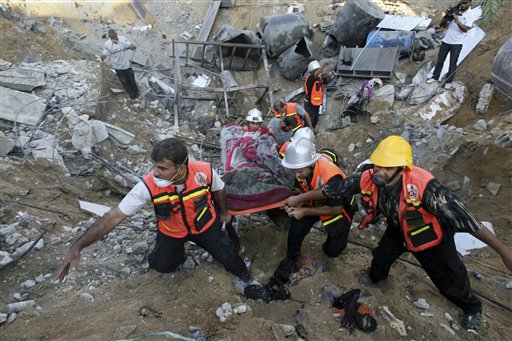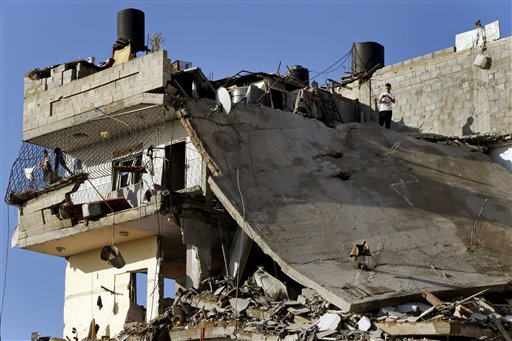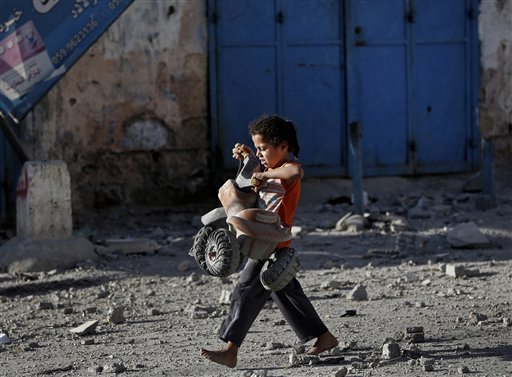Gazans dig dead from rubble in scenes of war devastation

Palestinian rescue officers remove a body from the rubble of a building where at least 20 members of the Al Najar extended family were killed, including at least 10 children, by an Israeli strike in Khan Younis, in the southern Gaza Strip, Saturday, July 26, 2014, according to Palestinian health official Ashraf al-Kidra. AP
GAZA CITY—Not a stone is left standing at the Najjar family home in southern Gaza. Yesterday it was a three-storey building, today medics dug 22 bodies of out the crater where it once stood.
The scene was one repeated across the Gaza Strip on Saturday, as desperate residents ventured out during a fragile 12-hour truce only to be met with evidence of death and destruction on a scale that reduced men to tears.
The Najjar family home was decimated in the final hours before the truce, in an Israeli air strike that killed at least 16 members of the family as well as others in their home and surrounding buildings.
Hussein al-Najjar looked at the rubble-strewn crater where his relatives took their last breaths early Saturday.
On the verge of tears, he appeared so deeply in shock he could barely speak.
Article continues after this advertisement“I was on the second floor on the balcony when the strike hit, and it threw me out and away from the building,” he said.
Article continues after this advertisement“My two sons were killed, and my wife, who was five months pregnant,” he said looking on with one eye, the other covered with a bandage.
His feet were swollen with bruising and his arms and legs also bandaged up.
Hussein’s shock left him quiet, but his grandmother raged in anguish at the scene.
“My entire family, my sons, grandchildren, are gone!” she shouted, beginning to weep.

Palestinians inspect damages of the el-Yazje family apartment building which was destroyed following an overnight Israeli missile strike in Gaza City, Thursday, July 17, 2014. The Israeli military says it has struck 37 targets in Gaza ahead of a five-hour humanitarian cease-fire meant to allow civilians to stock up after 10 days of fighting. AP
The 85-year-old woman, whose white hair protruded from beneath her headscarf, was surrounded by crying women and children who had come to pay their respects.
The crater that remained was filled with and surrounded by concrete rubble and twisted metal, with women and children’s clothes also littering the site.
Stench of death
From southern Gaza to the north, the pain was the same, as families returned to find their homes ground into rubble by relentless Israeli tank fire and air strikes.
In eastern Shejaiya, which saw some of the worst of the bombardment, entire blocks were erased, and there were macabre spots where human limbs could be seen emerging from the rubble.
“I’ve never seen anything like this in my life,” said 60-year-old Shifa Shamali.
“They destroyed my house, my son’s house, my daughter’s house… the whole area,” she cried.
Elsewhere in Shejaiya, normally home to 130,000 people, a man wore a mask to cover the stench of death as dust-covered bodies, some caked in dried blood, were carried away.
Corpses had rotted in the heat as continuous firing made it impossible for ambulances to retrieve the dead.
In Beit Hanun in the north, people braved Israeli army warnings not to return to their homes, and streets with trails of blood were criss-crossed by Israeli army tank tracks.
Medics said they had uncovered at least 100 bodies in the debris across Gaza, many of them charred and some stiff with rigor mortis.
For those who could, the 12-hour ceasefire was a chance to stock on up supplies that have run low in 19 days of devastating war between Israel and the Hamas movement.
Parents and children rushed out into Gaza City to buy food and gas canisters, or just to experience the feeling of walking outside without fear for the first time in nearly three weeks.

A Palestinian girl walks with a toy that she salvaged from debris of the el-Yazje apartment building which was destroyed following an overnight Israeli missile strike in Gaza City, Thursday, July 17, 2014. AP
Israeli army digs in
No one was sure whether the fighting would resume after the ceasefire, so residents hurried to prepare the dead, and to bury them while they could.
In Khan Yunis, several dozen men rushed down a high street carrying three bodies, one draped in a Hamas flag, another being sprayed with disinfectant.
A short distance to the east, few dared enter the border district of Khuzaa, where locals said Israeli tanks were patrolling and troops were setting up encampments as they sought to destroy Hamas tunnels.
A charred water tower marked the way to the center of the town, with a lone motorcycle driving away on its bombed-out dusty road.
“The army are still there, and they’re not moving,” said one resident.
RELATED STORIES
Israel to help Filipinos flee Gaza Strip
Israel approves four-hour extension of Gaza truce—TV